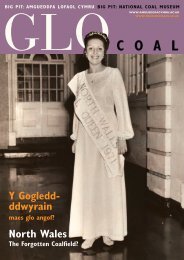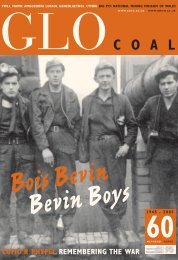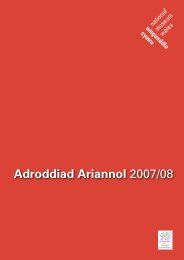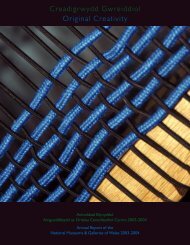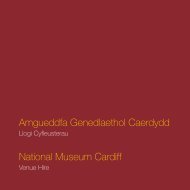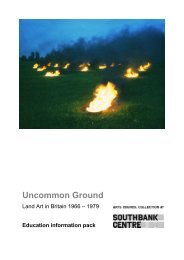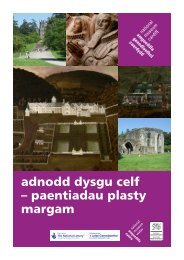You also want an ePaper? Increase the reach of your titles
YUMPU automatically turns print PDFs into web optimized ePapers that Google loves.
oherwydd fe ddeallais wedyn ei fod eisoes wedi tynnu<br />
llun o dri glöwr yn Nhonypandy, ond mai’n llun ni<br />
ddewisodd e maes o law. Roedd yn ffotograffydd<br />
profiadol ac yn gwybod yn union pa fath o ddelwedd<br />
yr oedd am ei chreu; fe wnaeth ‘droi’r’ llun hyd yn oed<br />
er mwyn cyflawni ei weledigaeth. Gallai fod wedi<br />
defnyddio’r lluniau a dynnodd yng Nghwm Rhondda,<br />
ond dwi’n credu ei bod yn well ganddo’r mannau<br />
agored ehangach yng Nghoed-elái, gyda’r lofa<br />
gyferbyn â strydoedd y pentref. Roedd hynny’n<br />
siwtio’i ddibenion yn well.<br />
Dim ond rhyw fachan tynnu lluniau oedd e ar y<br />
pryd. Doeddwn i’n gwybod dim am Eugene Smith er<br />
ei fod yn fyd-enwog. Ro’n i wedi clywed am gylchgrawn<br />
Life, fodd bynnag, fel darllenydd mawr. Wnes i erioed<br />
sylweddoli ’mod i’n rhan o ffotograff mor enwog tan<br />
iddo ymddangos yn y Western Mail ym 1986. Ers<br />
hynny, dwi wedi darllen tipyn o’i hanes mewn llyfrau<br />
ac ar y we, gan gynnwys ei anafiadau rhyfel, ei waith yn<br />
Japan a’i luniau o felinau dur Pennsylvania.<br />
Gorffennais weithio yn y lofa ym 1959 ar ôl<br />
llafurio’n gyson ar y ffas lo. Roeddwn i’n gweithio dwy<br />
si, ac roedd y si b’nawn yn fy nigalonni i braidd.<br />
Roedd fy mab newydd ei eni, a phenderfynais adael<br />
y pwll. Bues i’n gweithio i gwmni tarmacio, ar ffyrdd<br />
ac ystadau tai newydd – yn labrwr i ddechrau, yna’n<br />
gyrru peiriannau ac yn fforman maes o law. Aeth y<br />
cwmni i’r wal, ac ymunais â chwmni Burridge<br />
Construction fel fforman cyffredinol. Adfer hen<br />
lofeydd oeddem ni, yn tynnu hen adeiladau a<br />
thomenni. Aeth pethau i’r gwellt yn fan’ny hefyd, ac<br />
fe es i’n Glerc Gweithfeydd gyda Rhaglen Adfer Tir<br />
Cyngor Morgannwg. Ar ôl trychineb Aber-fan, roedd<br />
y Bwrdd <strong>Glo</strong> Cenedlaethol yn gwybod bod rhaid<br />
iddyn nhw fynd i’r afael â’r holl domennydd glo ar y<br />
mynyddoedd. Buon ni’n clirio safleoedd ar hyd a lled<br />
y De, gan gynnwys capio wyth sia yng Nghwm<br />
Garw yn unig – roedd hynny’n bedair blynedd o<br />
waith. Roeddem ni’n ailwampio’r Cymoedd! Er i mi<br />
ymddeol yn 65 oed, fe weithiais ar fy liwt fy hun am<br />
ryw ddwy flynedd arall. Yn wir, roeddwn i’n rhan o<br />
waith adfer <strong>Glo</strong>fa Coedely. Coed-elái oedd dechrau a<br />
diwedd fy ngyrfa, felly.<br />
Mae ‘ree Generations of Welsh Miners’ yn<br />
adrodd stori, stori am ddiwydiant glo a greodd ffordd<br />
o fyw a drosglwyddwyd o’r tad i’r mab (er nad oedd y<br />
tri yn y llun yn perthyn i’n gilydd o gwbl!). Daeth<br />
Eugene Smith i wledydd Prydain i dynnu lluniau o’r<br />
ymgyrchoedd etholiadol, ac i weld o ble y daeth<br />
pleidleisiau’r Blaid Lafur. Dwi’n credu ei fod wedi’n<br />
dangos ni ar ein gorau, wedi dangos ein dycnwch a’n<br />
hawydd i ennill. Llafurwr i’r carn oeddwn i bryd<br />
hynny hefyd, oherwydd roedd y syniad o ‘ni a nhw’<br />
yn gryf iawn iawn, a doeddech chi byth bythoedd yn<br />
pleidleisio i’r Tori!<br />
Vernon Llewelyn Harding<br />
covering the general election and did we mind if he<br />
took some photographs. He took about four photos<br />
aer arranging us to suit the shot. He got us all together<br />
and wanted Coedely village in the background. I think<br />
that he had thought of the composition of the photo<br />
previously as I found out later that he had already taken<br />
photographs of three miners in Tonypandy but we were<br />
the ones he chose. He was an experienced<br />
photographer and knew exactly what image he wanted;<br />
he even ‘flipped’ the photo to satisfy his vision. He<br />
could have used the photos he took in the Rhondda but<br />
I think that he liked the wider open spaces in Coedely<br />
which had the colliery opposite the village streets, it<br />
suited his purpose.<br />
It was just someone taking a photo, I didn’t know<br />
of Eugene Smith even though he was world famous,<br />
although I had heard of Life magazine as I have always<br />
been a big reader. I didn’t even find out that I was part<br />
of a famous photograph until it appeared in the<br />
Western Mail in 1986. Since then I’ve read quite a lot<br />
about him, both in books and on the internet, being<br />
wounded in the war, his work in Japan and his images<br />
of the Pennsylvania steel mills.<br />
I finished in the colliery in 1959 aer always worked<br />
on the coal face. I was working two shis and the<br />
aernoon shis were getting me down, my son had just<br />
been born and I decided to get out. I worked for a local<br />
tar marking firm on road construction and housing<br />
estates. I started off labouring, later drove machines and<br />
became a foreman. ey went through and I went with<br />
Burridge Construction as a general foreman. We<br />
reclaimed disused collieries, taking down old buildings<br />
and tips. en they went into liquidation and I went as<br />
Clerk of Works with the Glamorgan Council Land<br />
Reclamation Programme. Aer Aberfan the <strong>National</strong><br />
Coal Board knew they had to do something about all<br />
those coal tips up on the mountains. We sorted out sites<br />
all across south <strong>Wales</strong>, in the Garw Valley alone we<br />
capped eight shas – it took us four years. We were re<br />
shaping the valleys! I retired at 65 years old but I went<br />
back on a self employed basis for about two years<br />
aerwards. In fact I worked on the reclamation of<br />
Coedely Colliery. I started my working life in Coedely<br />
and I finished in Coedely.<br />
‘ree Generations of Welsh Miners’ tells a story,<br />
a story of how mining had created a way of life which<br />
had been handed down from father to son (even<br />
though none of us in the photo was actually related!).<br />
Eugene Smith came to Britain to photograph the<br />
election campaign and wanted to see where the<br />
Labour party got its voters from. I think that he<br />
showed us at our best, he showed our determination<br />
to win. Even then I was Labour through and through<br />
because it had been drummed into me that it was ‘us<br />
and them’ and you never, ever, voted Tory!<br />
Vernon Llewelyn Harding<br />
Y dyn<br />
weindio<br />
Cefais fy ngeni ar 8 Tachwedd 1916. Bu farw<br />
mam ym 1925 gan adael dad i fagu tri<br />
ohonom. Roedd rhaid iddo drefnu bod<br />
rhywun yn gwneud cinio i ni ar ôl ysgol. Doeddwn i<br />
ddim yno hanner yr amser, ta beth, oherwydd ro’n i’n<br />
cadw reiet gyda’r bechgyn eraill ar y stryd. Bydden<br />
ni’n clymu darn o linyn ar gnocer drws, rhedeg tu ôl<br />
i’r wal agosaf cyn tynnu’r llinyn a tharo’r drws. Pan<br />
fyddai’r dyn yn agor y drws, roedden ni’n gollwng y<br />
llinyn yn sydyn a chuddio tu ôl i’r wal. Felly, byddai’n<br />
cau’r drws a ninnau’n taro’r cnociwr eto, cyn rhedeg<br />
fel cath i gythrel ar ôl iddo’n gweld ni.<br />
Dechreuais weithio fel gwas colier ym mhwll Rhif 8<br />
Tylorstown pan oeddwn i’n 14 oed. Dyna’r unig waith<br />
oedd ar gael ar y pryd; naill ai mynd yn fachgen delifro<br />
am ryw 5 swllt yr wythnos neu lawr i’r lofa am dri swllt<br />
ar ddeg. Y pwll aeth â hi, felly. Roedd yn wych, achos<br />
doeddwn i erioed wedi cael llawer o arian cyn hynny,<br />
heblaw am chwe cheiniog yr wythnos gan y fenyw drws<br />
nesaf am nôl bara iddi o’r pobydd, a swllt a chwech am<br />
werthu wyau ar ran y ffermwr ar benwythnosau. Hyd yn<br />
oed ar ôl i mi ddechrau ennill cyflog, roedd fy modryb<br />
yn cymryd pymtheg swllt oddi arnaf fel costau llety. Dim<br />
ond 17 swllt oedd fy nghyflog ar y pryd, a byddwn i’n<br />
gwario’r ddau swllt dros ben ar sigaréts i mi fy hun. Pan<br />
oedd fy ffrindiau’n mynd mas i fwynhau, felly, roeddwn<br />
i’n gorfod aros gartre’ heb yr un ddimai goch.<br />
Roedden ni’n cloddio gwythïen 2 droedfedd 9<br />
modfedd, a olygai ein bod ar ein pengliniau bron drwy’r<br />
dydd. Gan fod y ‘bos’ (y glöwr hŷn) yn gweithio ar ei ochr,<br />
byddai’n gorfod torri i waelod y glo nes ei fod yn torri’n<br />
rhydd mwya’r sydyn. Roedd pa mor gyflym y byddai’r<br />
glo’n gollwng yn dibynnu ar natur y wythïen, ond gallech<br />
chi fod yno am hanner awr neu fwy gyda’ch mandrel.<br />
Ar ôl i’r glo ollwng o’r graig, byddai’n disgyn gyda<br />
‘bwff’, yn llithro i lawr, a byddwn i’n gorfod codi’r glo i’r<br />
bocs cwrlo a’i lusgo i fyny er mwyn llenwi’r dram. Un byr<br />
oeddwn i bryd hynny, ac felly roedd rhaid i mi gael bocs i<br />
sefyll arno wrth ochr y dram er mwyn i mi allu codi’r glo.<br />
Roeddwn i wedi blino’n shwps erbyn i mi gyrraedd adref.<br />
Ar ôl ei gludo i wyneb y pwll, byddai’r holl lo’n cael<br />
ei ddidoli yn y sgriniau glo. Doedden nhw ddim yn<br />
defnyddio’r glo bach yn y dyddiau hynny, felly byddai’n<br />
mynd lan i’r domen. Roedd slag o bedair glofa, Rhif 6 a<br />
7, a Rhif 8 a 9, yn cael ei roi ar y domen honno. Mae’r<br />
domen yno o hyd, ac mae’r bechgyn lleol yn ei<br />
defnyddio heddiw i fynd lan a lawr gyda’u beiciau<br />
modur. Pan oedden ni’n fechgyn ysgol, bydden ni’n<br />
disgwyl i’r dramiau llawn fynd i fyny’r domen cyn neidio<br />
ar y cyplynnau a chael li i’r brig rhwng y dramiau. Un<br />
diwrnod, fe lithrodd bachgen a cholli’i goes.<br />
The<br />
winding man<br />
Iwas born on the 8th of November 1916. My mother<br />
died in 1925 and my father had three of us and he<br />
had a job looking aer us. He had to get someone<br />
to make lunch for us aer school. I wasn’t there half<br />
the time anyway because I was usually out with the<br />
boys in the street into devilment. We used to tie a<br />
string around the knocker on a door and go and hide<br />
behind the wall and pull the string and the knocker<br />
would go. When the man came to the door you’d let<br />
the string go and we’d be hiding behind the wall. So<br />
he’d shut the door and we’d do it again and when he<br />
came out again and caught us, we’d run like hell.<br />
At the age of fourteen I began work as a collier’s boy<br />
in Tylorstown Number 8 Pit. at was really the only<br />
work available then; it was either taking a job as a<br />
delivery boy for about five shillings a week or going<br />
down the colliery for thirteen shillings, so I went into<br />
the pit. at was great as I’d not had a lot of money<br />
before then, except the woman next door would give me<br />
6d a week to fetch the bread from the bakers for her and<br />
I sold eggs for the farmer on the weekend for another<br />
1s 6d. Even so, aer I started earning, I was lodging with<br />
my aunt and she was taking 15s off me and I was only<br />
having 17s at the time. So I had 2s for myself for<br />
cigarettes and when all my mates were going out here<br />
and there I couldn’t go because I didn’t have the money.<br />
We worked the 2 9in seam and of course you<br />
were on your knees practically all day. e ‘boss’ (the<br />
adult collier) worked on his side, and he would have<br />
to cut into the bottom of the coal and all of sudden it<br />
would ‘bust’ and become loose. It depended on the<br />
nature of the coal seam how quickly the coal would<br />
release but you could be there half an hour or more<br />
with that mandrel.<br />
Aer the coal is released it would all come out<br />
with a ‘bwff ’, slide out, and then I’d have to get that<br />
coal into the curling box and I’d be dragging it back<br />
up to fill the dram. And I was short then so we had to<br />
have a box at the side of the dram for me to stand on<br />
so I could li it and put the coal into the dram and I<br />
was really tired by the time I went home.<br />
All the coal went up to the surface and then it’d go<br />
to be sorted out in the coal screens. e small coal<br />
wasn’t used in those days so that would go up to the tip.<br />
Now that tip was taking the slag from four collieries,<br />
the No. 6 and 7, and the No. 8 and 9. You can still see<br />
the tip the local boys use it now for motor bikes going<br />
up and down. When we were schoolboys we would<br />
wait for the full drams going up the tip and you would<br />
jump on the shackle and get a li up between the<br />
drams. A boy slipped one day and lost his leg.<br />
12 13





